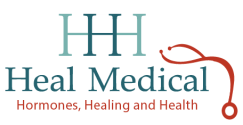Estrogen – The female hormone
Estrogen is a hormone familiar to most everyone. It is what makes us female. It makes women have soft skin and curves, high lilting voices, and breasts. It has over 400 functions in the body and has a powerful emotional, psychological, and physical effect on our body. It is produced primarily by a woman’s ovaries and a small amount is produced by the adrenal glands. At menopause, a precipitous fall in estrogen (as well as progesterone, which we will discuss later) leads to changes in the body that can cause symptoms that most people are familiar with such as hot flashes, insomnia, mood swings, vaginal and genital atrophy, and depression as well as an overall decline in general well being.
Estrogen as treatment and drug
Many women have great difficulty dealing with the symptoms of menopause and find themselves with an unwelcome decline in their quality of life. Estrogen has been prescribed for over 40 years to women for the symptoms of menopause with great success. Many women feel so much better that they continue to take estrogen for the rest of their lives. But even though estrogen is effective, it has taken a bad rap due to misunderstanding, confusion, and poorly designed research studies. To further complicate matters, estrogen comes in both synthetic and natural or bio identical form. Doctors and researchers use these interchangeably in the literature even though they have greatly different effects on the body. Premarin is a patented synthetic conjugated estrogen made from pregnant mares. It resembles estradiol, (the most active estrogen) but is biochemically different. Bio identical estradiol is made from soy and is engineered to be exactly the same as the estradiol that occurs in your body. It cannot be patented because it is considered a natural substance.
Estrogen benefits and risks
The benefits of estradiol are many. A few of the most important are decrease in osteoporosis, colon cancer, cardiovascular disease, Alzheimer’s and general cognitive decline, and overall benefit in slowing or preventing the aging process. Estradiol promotes healthy genital tissue and soft skin with decreased wrinkling. It decreases the risk for diabetes, macular degeneration, and prevents tooth loss with aging by promoting a healthy oral mucosa.
Research, media and main studies
Estradiol increases the risk for endometrial cancer when given alone or “unopposed”. Estradiol has been found to increase the risk for breast cancer in some instances. Hormone replacement therapy (HRT) was first given as estradiol alone (Premarin) and was extremely effective in treating the symptoms of menopause. When it became known that estradiol alone increased the risk for endometrial cancer, a synthetic progestin (Provera or methoxyprogesterone) was added and this prevented the endometrial build up. The initial studies done on HRT used these synthetic hormones. It has been observed that women have a lower risk for cardiovascular disease (CVD) than men. This was attributed to estrogen as women quickly catch up to men in CVD risk after menopause. CVD remains the #1 killer of Americans by far, resulting in 400,000 deaths per year. The Nurses Health Study was an observational study with 48,470 postmenopausal women that was conducted over 10 years. A significant finding that came from this study was that the relative risk for major coronary disease was reduced by almost 50% for current users of HRT. Interestingly, in this cohort 72% of the women took UNOPPOSED (no Provera or medroxyprogesterone) estrogen. This study came out in the early 90’s and as physicians, we were told of these amazing results and it was recommended to prescribe HRT to everyone. HRT meant Premarin alone OR Premarin plus Provera, essentially viewing them as the same treatment . In the late 90’s the HERS study came out and threw everyone in a dither as it did not show a reduction in CVD events AND it increased the risk for blood clots. This study involved 2,763 postmenopausal women with KNOWN CVD which is a very different group than the women in the Nurses Health Study. This study made it clear that starting women with CVD on oral Premarin was dangerous.
The Women’s Health Initiative (WHI) was begun in the early 90’s and was to be the grandmother of all studies and was to answer all our questions about HRT. The problem is it seemed to create more questions that it answered and since then confusion has reigned. Unfortunately all these major studies used synthetic hormones as HRT – either estrogen in the form of Premarin or Premarin plus Provera.
The WHI had 16,608 post menopausal women age 50-79 and the estrogen/progestin arm was stopped early due to an increased risk for heart attack, stroke, blood clots, and breast cancer. In women 65 and older there was an increased risk for dementia and cognitive decline. A subset arm of the study, the estrogen only arm, was continued, and it was found that younger women age 50-59 who took Premarin had significantly reduced buildup of calcium in their arteries compared to their peers who did not take HRT. After 7 years of follow up, the estrogen only group had more abnormal mammograms but no significant increase for breast cancer, however early on did show increased risk for blood clots which went away after a year of therapy. It was concluded that the increased risk for breast cancer in the estrogen/progestin arm may be due to the progestin. After 10 years of follow up, it appears that there is a slight increase risk for breast cancer (1 in 10,000) particularly in women with an increased risk when taking Premarin.
A French study involving 54,540 women showed that there was no increased risk for breast cancer in women taking oral micronized progesterone. After 8 years of follow up there was a 60% increase risk for breast cancer in those who took estrogen plus progestin but no increase in those who took estrogen plus oral micronized progesterone.
The Million Women study is a European study involving over a million women to assess the different types of hormone therapy. There was an increase risk for breast cancer in all types of HRT given, oral, transdermal, or implant with the most risk occurring in the estrogen/progestin group. Micronized progesterone was not used in this study.
Conclusions
So if you have taken the time to read through this, you can see that it is complex . Throw into this the economic impact of two very profitable drugs (Premarin and Provera), media misunderstanding and misguided information, differing physician opinions, and you have a confusing picture for a woman facing menopause.
It is my opinion that estrogen when prescribed appropriately and combined with necessary other essential hormones is instrumental in preventing the ravages of aging and chronic disease. It significantly enhances quality of life as well. The safest hormone replacement therapy to take is bio identical hormones. The above studies show that synthetic hormones are dangerous, particularly medroxyprogesterone or Provera.
A well written straightforward assessment of bio identical hormones is provided by “How to Achieve Healthy Aging”, by Neal Rouzier, MD. It provides you all the information you need to understand and decide if bio identical hormones are right for you. Dr. Rouzier practices age management medicine in Palm Springs and Palm Desert, CA. http://www.amazon.com/Achieve-Healthy-Aging-M-D-Rouzier/dp/0971000735



[…] It has over 400 functions marshanunleymd.wordpress.com […]
[…] Nunley, MD Skip to content HomeAbout ← Estrogen – A Hormone Much Maligned Testosterone – The Hormone of Love → March 9, 2011 · 10:36 pm ↓ […]
[…] cortisol. The thyroid needs cortisol to govern its function. The production of progesterone, estradiol, testosterone, DHEA, pregnenelone; all hormones of the steroid hormone cascade, will decrease and […]
[…] hormonal cascade and is a precursor for all the other steroid hormones: progesterone, cortisol, estradiol, testosterone, and DHEA. Like the other steroid hormones, pregnenolone declines with age to […]
[…] for Breast Cancer – Women in the WHI who took estrogen and progestin (not progesterone) had an increased risk for breast cancer with 2.6 breast cancer […]
[…] until one has the disease and treatments frequently have significant side effects. We now know that estrogen and its partner hormones may not be enough to prevent osteoporosis. I have my hormones perfectly […]